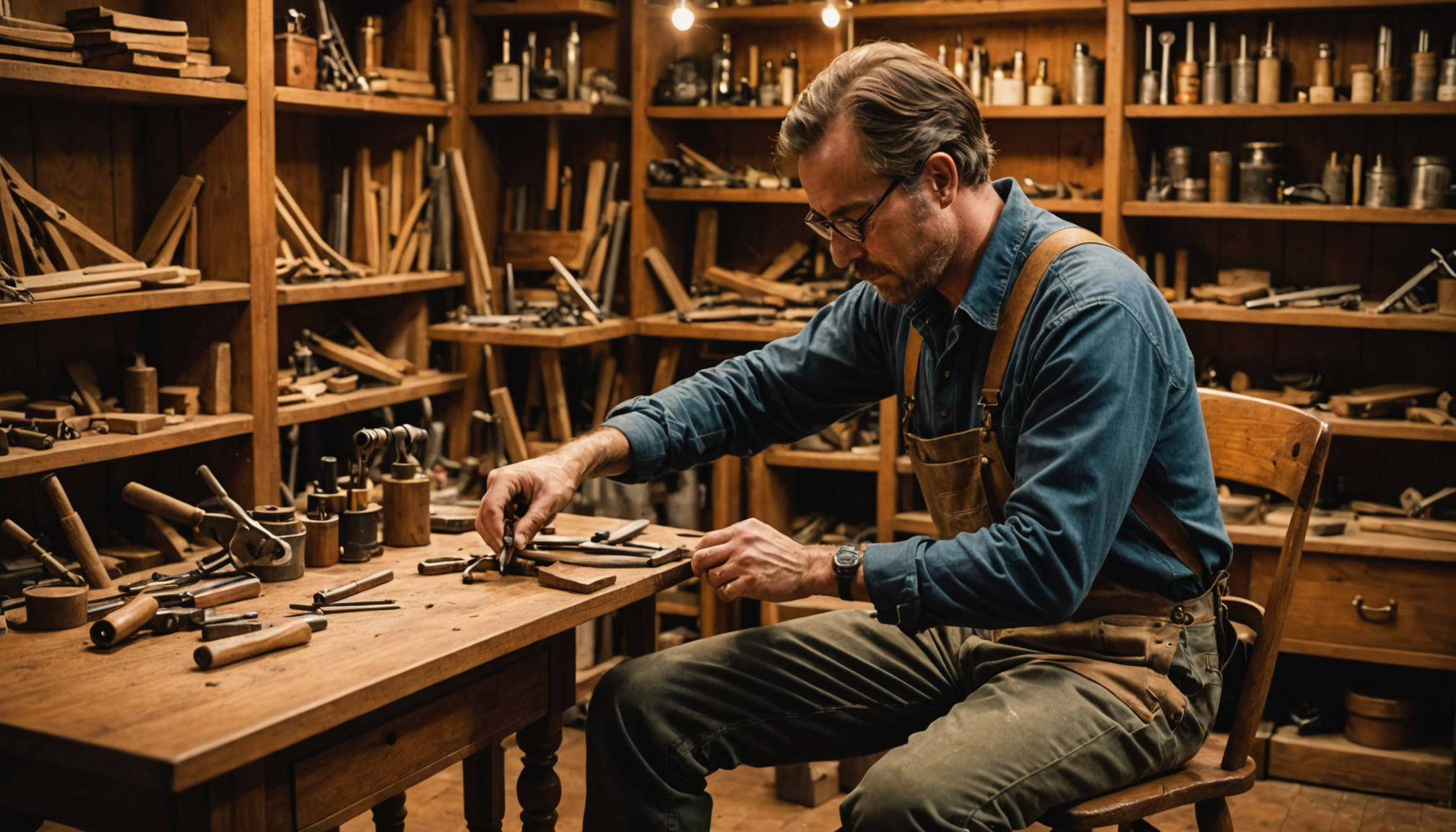When it comes to maintaining the aesthetics and functionality of furniture, professional repair services play an indispensable role in addressing a variety of common issues. These issues can range from the subtle to the significant but all share potential solutions through expert intervention.
One prevalent problem that often necessitates repair is the structural weakening of furniture, which can manifest as wobbly legs, loose joints, or cracked frames. Over time, the repeated stress of daily use can compromise the integrity of these components. A skilled furniture repair professional can reinforce and restore the structural stability by using techniques like doweling, metal bracing, or re-gluing, thereby prolonging the piece’s usability.
Another typical issue is the degradation of upholstery materials. Fabric and leather surfaces are particularly susceptible to wear and tear, resulting in unsightly tears, stains, or fading. Professional repair services can revitalize upholstery through cleaning methods tailored to specific materials, patching, restuffing, and, if necessary, complete re-upholstery. This not only recovers the furniture’s visual appeal but also its comfort and practicality.
The aesthetic aspects of wood furniture—such as scratches, dents, or watermarks—pose yet another set of challenges. These imperfections can not only diminish the attractiveness of the furniture but also impair its surface protection. Furniture repair experts can restore wood surfaces using a variety of techniques like sanding, refinishing, or applying special fillers and lacquers, which help in blending repairs seamlessly with the existing finish.
Additionally, malfunctioning mechanisms, common in items such as reclining chairs, swivel bases, or extendable tables, often require specialized attention. A professional can diagnose the precise problem, whether it involves a simple tightening of loose screws or more complex mechanical failures, to ensure smooth operation. Replacement of small parts or realignment is performed with precision to extend the furniture’s utility and prevent future failures.
To better understand how these repairs address common issues effectively compared to leaving the problems unresolved, consider the following comparison:
| Issue | Without Repair | With Professional Repair |
| Wobbly Legs | Potential risk of collapse and further damage | Reinforced strength and longevity |
| Worn Upholstery | Aesthetic decline and reduced comfort | Restored appearance and comfort |
| Scratched Wood | Visual damage and exposed surfaces | Enhanced finish and protection |
| Faulty Mechanisms | Non-functional or inconsistent use | Renewed functionality and reliability |
Addressing these common furniture issues not only enhances the immediate appearance and functionality of beloved pieces but also fortifies them against future wear, ultimately maximizing their potential for continued use in homes and offices alike.
cost-effectiveness of repair vs. replacement
When considering whether to repair or replace a piece of furniture, cost is often the most significant factor in decision-making. Professional furniture repair offers a cost-effective alternative to replacement, which can save individuals significant amounts of money while retaining sentimental and historic value in the furniture.
1. Initial Assessment:
– Cost of Replacement: Begin by evaluating the cost of replacing the piece. Research similar items in retail stores or online marketplaces to establish a baseline for replacement cost.
– Repair Cost Estimation: Obtain a detailed quote from a professional furniture repair service. This should include all aspects of repair such as materials, labor, and any additional fees. Consider seeking multiple quotes for comparison.
2. Consider the Extent of Damage:
– Minor Issues: For issues like small scratches, loose joints, or minor tears in upholstery, repairs are usually much cheaper and quicker than buying new.
– Major Damage: Larger issues, such as broken frames or severely damaged upholstery, may require more extensive repair, which can still be cost-effective compared to purchasing high-quality new furniture.
3. Evaluate the Value of the Furniture:
– Sentimental Value: Items with sentimental or historical value are often worth the repair investment, as these aspects cannot be replaced.
– Monetary Value: For antique or high-quality custom pieces that hold their value, repairs can be a wise financial decision to maintain or even increase their value over time.
4. Quality and Longevity:
– Material Quality: High-quality materials used in some older furniture pieces can make repair more favorable, as modern replacements may not offer the same durability or aesthetics.
– Longevity of Repairs: Consider the anticipated longevity of the repair. A professional repair will often restore the piece’s usability for many years, potentially longer than a cheaper modern replacement.
5. Hidden Costs of Replacement:
– Assembly and Delivery Fees: Many new furniture purchases require additional costs for delivery and assembly, which can significantly add to the overall cost.
– Time and Effort: The effort and time involved in selecting, ordering, and setting up new furniture should also be factored into the decision.
6. Decision Outcome:
– After analyzing all factors, weigh the total estimated costs of repair and replacement against their respective benefits. If professional repair provides a favorable balance between cost and restored quality, it is the more cost-efficient option.
In conclusion, professional furniture repair emerges as a viable and often more economical option compared to replacement. It allows individuals to preserve the integrity and tradition of their existing pieces, while also respecting the financial constraints and personal values associated with each piece.
environmental benefits of furniture repair
Choosing to repair rather than replace damaged furniture can significantly contribute to reducing your environmental footprint. In today’s world, where sustainability is increasingly important, furniture repair stands out as a highly effective eco-friendly practice with multiple key benefits.
Firstly, furniture repair minimizes waste production. When furniture is discarded, it often ends up in landfills, contributing to the growing issue of waste accumulation. The materials used in furniture, such as wood, metal, and synthetic compounds, can take years to decompose. By opting for repair, you help reduce the volume of waste generated, extending the useful life of each piece and curbing the demand for landfill space.
Moreover, furniture repair saves valuable resources. Manufacturing new furniture requires a substantial amount of raw materials, including wood from forests, metals from mines, and various synthetic components. These materials not only have to be extracted but also processed and transported, which consumes energy and other resources. By repairing rather than replacing, you support resource conservation and lessen the strain on these natural reserves.
The process of manufacturing new furniture also involves significant energy consumption and carbon emissions. Factories that produce furniture consume electricity and other forms of energy, often derived from fossil fuels, leading to the release of greenhouse gases. Repairing furniture uses considerably less energy, as it typically involves localized work with minimal machinery. This makes repair a more sustainable option, contributing to lower carbon emissions and a reduced carbon footprint.
Furniture repair also plays a role in preserving the biodiversity of ecosystems. Sourcing raw materials for new furniture, particularly wood, can lead to deforestation, which in turn affects wildlife habitats and ecological balance. By reducing demand for new materials through repair, you indirectly support efforts to protect these natural environments.
Additionally, repair and restoration increase awareness and appreciation for sustainable practices. As more consumers opt for furniture repair, the demand for sustainable solutions rises, encouraging producers and service providers to innovate and prioritize environmentally friendly options. This consumer-driven shift can lead to broader changes within the industry, ultimately advancing the global sustainability agenda.
Choosing professional furniture repair not only satisfies immediate furniture needs but also aligns with ethical and environmental considerations. It offers a tangible way to contribute positively to environmental conservation efforts, ensuring that future generations inherit a healthier planet.
enhancing the lifespan of furniture
Investing in professional furniture repair significantly enhances the lifespan of furniture pieces, an advantage that translates into both economic and sentimental value over time. Professional repair services use specialized techniques and high-quality materials to restore and reinvigorate furniture, ensuring it remains functional and visually appealing for years to come.
Mortise and tenon joints, dovetail joinery, and other traditional furniture-making techniques are often involved in professional repairs, enhancing the strength and durability of the construction. By reinforcing these critical areas, repair experts can prevent the kind of wear and deterioration that might otherwise lead to the necessity for complete replacement. This meticulous attention to structural integrity safeguards against future breakdowns and extends the furniture’s useful life.
Moreover, expert repair often involves restoring the original finish and patina of the wood, leather, or fabric, which helps maintain the piece’s aesthetic appeal. The use of quality sealants and finishes not only revives the furniture’s look but also adds a layer of protection against future scratches, stains, and other forms of damage. The result is a piece that not only looks as good as new but may also possess improved resistance to wear, further prolonging its lifespan.
Considering modern furniture trends, where materials might not always meet the robustness of heirloom or mid-century designs, extending the longevity of existing pieces is particularly valuable. This approach respects and harnesses the superior design and material quality of older furniture, which may incorporate premium woods and solid construction not typically found in newer, mass-produced items. By opting for repair, you effectively preserve the unique characteristics and craftsmanship of older pieces, keeping them in service within your living or work spaces.
Ultimately, the decision to repair professionally involves assessing not just the immediate benefits of restoration but also considering the long-term value gained from continued use. Repairing allows you to relish the comfort and familiarity of well-loved pieces while ensuring they remain integral parts of your environment far longer than they might have otherwise. As you consider your next steps, remember the value of prolonging such enduring assets, appreciating both their personal and practical benefits.
choosing a professional furniture repair service
Selecting the right professional furniture repair service is a crucial step in ensuring the quality and longevity of your furniture restoration project. With numerous options available, it can be challenging to discern which service will best cater to your needs. Begin by researching various repair services in your area, paying attention to their reputation and customer reviews, which can offer valuable insights into their reliability and craftsmanship. Seek recommendations from friends or family who have previously used such services, as firsthand experiences often provide a reliable reflection of expectations and outcomes.
Another key factor to consider is the expertise and experience of the repair professionals. Inquire about their qualifications, years of experience, and areas of specialization. A skilled artisan with a proven track record in repairing specific types of furniture or materials will likely provide superior results. Assess previous work examples or portfolios to get a sense of their style, attention to detail, and ability to handle similar issues to those your furniture may encounter.
Communication and transparency are also critical aspects of a good repair service. Ensure that the service provider is willing to discuss the repair process, costs, and expected outcomes in detail. A reputable repair service will offer a clear and detailed estimate, breaking down the costs for materials, labor, and any additional charges upfront, without hidden fees or surprises. They should also be open to discussing potential challenges and offer practical advice on how best to proceed with the repair to meet your budget and needs.
Finally, consider the level of customer service and convenience provided. Does the repair service offer pickup and delivery options, or do you need to arrange transportation yourself? Look for services that prioritize customer satisfaction and offer flexible scheduling options to accommodate your needs. The ability to maintain open lines of communication throughout the repair process is essential to ensuring that the final result aligns with your expectations.
In conclusion, professional furniture repair offers numerous benefits, from addressing common issues and being cost-effective to providing environmental advantages and extending the lifespan of your beloved pieces. Selecting a reliable service is key to maximizing these benefits, ensuring that your furniture not only regains its former glory but also continues to serve you for many years to come. Embrace the opportunity to preserve your furniture’s charm and functionality while contributing to a more sustainable and economically sound choice.


